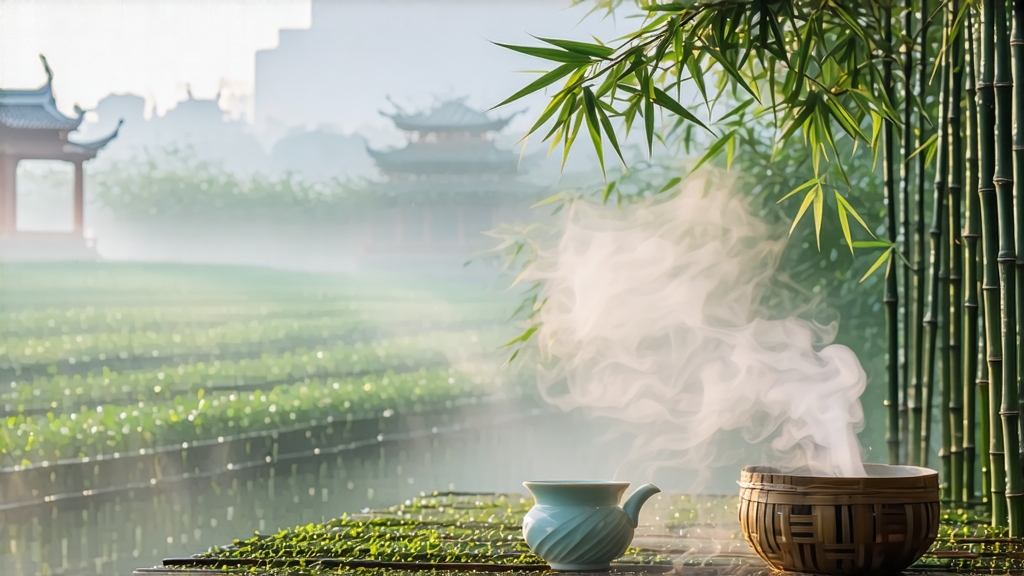
Biluochun, whose name translates literally to “Green Snail Spring,” is one of China’s ten most celebrated teas, yet it remains a quiet mystery outside the circles of serious connoisseurs. Produced only in a handful of fog-locked hills straddling Lake Tai and the Dongting mountains of Jiangsu, this tea carries within its tiny, tightly curled leaves the perfume of apricot blossoms, the sweetness of lake air, and the craft traditions of four centuries. To understand Biluochun is to listen to a spring morning condensed into a single sip.
Historical whispers place the tea’s birth during the late Ming dynasty, when a tea picker, startled by the sudden fragrance of tea leaves mixed with surrounding fruit trees, christened the brew “Scary Fragrance” (Xia Sha Ren Xiang). The Kangxi Emperor, touring the region in 1699, found the name inelegant and rechristened it Biluochun, referencing the spiral shape of the finished leaf and the season of harvest. The imperial seal instantly elevated the tea to tribute status; for three hundred years, every spring, the finest kilo was couriered to the Forbidden City wrapped in silk and lotus leaves.
Strictly defined, authentic Biluochun comes from only two micro-zones: Dongting East Mountain and Dongting West Mountain, islands that rise from Lake Tai like the humps of submerged dragons. Within these zones, the cultivars must be the small-leaf “Xiaoye” group—trees that hug the ground, drawing moisture from the lake and perfume from the interplanted fruit orchards. Peach, plum, apricot and loquat bloom at the same time as the tea buds awaken; bees shuttle between petals and leaf, and the tea absorbs what the French would call “terroir,” the Chinese simply call “the breath of flowers.”
Harvest begins when two leaves and a bud are still shorter than a thumbnail, usually between the Qingming and Grain Rain festivals. Pickers work before sunrise, selecting only the erect, ivory-tipped shoots that glisten with dew. Speed is vital: the same bud that is silk in the morning can be leather by afternoon. Each kilogram of finished tea demands sixty to eighty thousand of these shoots, all plucked by fingers trained since childhood to pinch, never pull, so the bush remains unbruised for the next flush.
Withering is skipped; instead, the leaves are immediately “shaqing” or kill-green in woks heated to 180 °C. A master fryer tosses the leaves against the iron wall with a bamboo brush, the motion resembling a calligrapher’s vertical stroke. Within three minutes the moisture drops from 75 % to 55 %, enzymes are frozen, and the grassy volatiles are replaced by a nutty, slightly marine bouquet. The wok is then cooled to 80 °C for the rolling phase. Here the fryer presses the leaves against the wok with ten fingers while rotating the wrist clockwise, coaxing the leaf into the signature spiral. One lapse in pressure and the coil loosens, downgrading the tea from Supreme to First Grade. Finally, a gentle 60 °C bake dries the leaf to 5 % moisture, locking the white downy tips into a silver frost that glints under light.
The finished leaf is petite—no longer than 1.5 cm, dark jade on the back, lake-green on the belly, wound so tightly it resembles a snail or, as poets prefer, a young girl’s earring. When dropped into a warmed gaiwan, the coils twitch, then slowly unfurl like miniature ferns. The first infusion yields a pale champagne liquor with a ring of jade at the rim; the aroma is a duet of white peach and fresh chestnut. On the tongue, the tea enters sweet, retreats minerally, then finishes with a lingering floral echo that can last ten minutes. Connoisseurs call this “returning fragrance” (hui gan), a sensation that arrives only after the liquor has been swallowed, as if the lake itself were breathing through you.
To brew Biluochun properly, begin with soft water brought to 75 °C—any hotter scalds the down and releases tannic bitterness. Use a tall, thin glass or a porcelain gaiwan; glass allows you to watch the leaves dance, porcelain preserves aroma. For every 150 ml, measure 3 g of leaf, roughly one level teaspoon. Pre-warm the vessel, then slide the leaves against the wall so they cascade like green snow. Shake gently to awaken aroma,